Department of Agricultural Microbiology & Bioenergy, College of Agriculture, Professor Jayashankar Telangana State Agricultural University, Rajendranagar, Hyderabad-500030,Telangana ,India.
Corresponding author Email: shravani4335@gmail.com
Article Publishing History
Received: 18/04/2019
Accepted After Revision: 19/06/2019
A field experiment was carried out on the effect of bio fertilizers under drip fertigation system on nutrient uptake and yield performance in Green gram Vigna radiata. It was conducted at water technology centre fields, college farm, College of Agriculture, PJTSAU, Rajendranagar, Hyderabad, Telangana during kharif 2016 – 2017 with one of the objectives of nutrient uptake and yield performance of Green gram, variety (MGG – 295) under drip fertigation system. The experiment was laid out in randomized block design with three replications along with 10 treatments. The liquid bio inoculants viz., Rhizobium and PSB were used under drip fertigation system. The results of the field experiment indicated that the treatment T6 with combination of 100 % RDF along with LBBF drip fertigation recorded significantly highest N, P and K uptake were 62.23, 26.60 and 51.33 kg ha-1 respectively and significantly highest seed yield (1019.50) kg ha-1 recorded with treatment (T6) when compared to all the treatments. Further, the percent of seed yield increased over control by 23.93 %.
Bio fertilizers, biofertgation, microbial inoculants seed yield, nutrient uptake.
Shravani K, Triveni S, Latha P. C, Ramulu V. Comparative Effect of Bio Fertilizers Under Drip Fertigation System on Nutrient Uptake and Yield Performance in the Green Gram, Vigna radiata. A Retrospective Study. Biosc.Biotech.Res.Comm. 2019;12(2).
Shravani K, Triveni S, Latha P. C, Ramulu V. Comparative Effect of Bio Fertilizers Under Drip Fertigation System on Nutrient Uptake and Yield Performance in the Green Gram, Vigna radiata. A Retrospective Study. Biosc.Biotech.Res.Comm. 2019;12(2). Available from: https://bit.ly/2Xt8FAU
Copyright © Shravani et al., This is an open access article distributed under the terms of the Creative Commons Attribution License (CC-BY) https://creativecommns.org/licenses/by/4.0/, which permits unrestricted use distribution and reproduction in any medium, provide the original author and source are credited.
Introduction
The high inputs of chemical fertilizers have not only caused environmental problems but also become a cause of concern for human health. Bio fertilizers have been identified to address the issue of excessive use of chemical fertilizers as they are one of the sustainable source of supplementation to chemical fertilizers for Agriculture. The term Bio fertilizers generally are defined as preparation containing live or latent cells of efficient strains of Nitrogen fixing, Phosphorus solubilizing or cellulolytic microorganisms used for application to seed or soil. Intensified use of bio fertilizers emerging as an environmentally-friendly alternative soil fertility management practice with potential to increase and cheaply sustain crop yields compared with continuous application of inorganic fertilizers alone (Sharma et al., 2013). It is also play an important role for supplementing the essential plant nutrients for sustainable agriculture. Bio fertilizers are low cost and economically viable technology which improves plant growth and development. These are reduce the environmental pollution caused by chemical fertilizers, protect plants against many soil-borne pathogens and help the plant to grow under stress conditions (Brahmaprakash and Sahu, 2012).
Liquid bio fertilizers of good quality hold great promise in agriculture because of benefits over the conventional carrier based bio fertilizers such as Rhizobium and PSB inoculants are often exposed to un favorable stresses when inoculated seed were planted in the soil. These stresses include such things as low or high pH, high temperature, low moisture and high salt concentrations. Therefore, the Rhizobia and PSB inoculants should be tolerant to these stresses (Liu et al., 2009), have protecting materials in the inoculants formulation or have adaptive mechanisms that increase their tolerance. Because of these advantages over the conventional carrier based bio fertilizers, the liquid bio fertilizers has great importance in yield increased aspects in agriculture.
Green gram [Vigna radiata (L.) Wilczek] also known as mung bean is a self-pollinated leguminous crop which is grown during Kharif (July- October) as well as summer (March- June) seasons in arid and semi arid regions of India. It is primarily a rainy season crop but with the development of early maturing varieties, it has also proved to be an ideal crop for spring and summer season. It is tolerant to drought and can be grown successfully on drained loamy to sandy loam soil in areas of erratic rainfall. It is a native of Central Asia. It is a short duration crop, fits well in various multiple and intercropping systems. India is a leading green gram cultivator, with up to 55% of the total world acreage and 45% of total production (Singh et al., 2013; Rishi et al., 2009). It is one of the most important pulse crops for protein supplement. The major advantage of liquid bio fertilizers having long shelf life, ( Bhavya et al., 2017).
Efficient management of water is of outmost importance for sustaining and enhancing Agricultural production (Palanisami et al., 2012). Drip fertigation allows precise timing and uniform distribution of fertilizer nutrients, and is an efficient and agronomically sound method of providing soluble plant nutrients directly to the active plant root zone. Biofertigation is the efficient and precise use of beneficial microorganisms through a microirrigation system. Biofertigation offers vast scope for minimizing the use of chemical fertilizers. fertigation is definitely advantageous over the surface irrigation with basal application of fertilizers with optimum moisture supply and timely nutrient application (Jeyajothi and Pazhanivelan, 2017). There are more chances for increasing the yield, quality, fertilizer-use efficiency, water-use efficiency, and economic output. With drip fertigation and in combination with organics, there is possibility for organic farming to be intensified in the future.
Material and Methods
The field experiment was conducted at water technology centre fields, college farm, College of Agriculture, PJTSAU, Rajendranagar, during kharif 2016 – 2017. The location is geographically situated at 17° N Latitude and 78° E longitude at an altitude of 542.3 m above MSL. The soil of an experimental site was sandy loam in texture, moderate in organic carbon, low in nitrogen and medium in available phosphorus and high in potash and slightly alkaline (pH 7.6) in chemical reaction. The seed of green gram (Cv. MGG 295) was obtained from Agriculture Research Station, Madira, Khammam. Seed treatment with microbial inoculants (carrier): After quality testing of the bioformulation, the good quality bio inoculants were used for the field experimentation to study the performance on yield of green gram crop. Twenty grams of jaggery was dissolved in 200 ml of water. Jaggery solution was prepared as per the volume of seed. The Rhizobium & PSB cultures were thoroughly mixed for slurry preparation. Seeds were treated with this mixture carefully, so that seed coat was not injured and a uniform coating was made. Treated seeds were dried under shade on gunny bags and then used for sowing. Seed treatment with microbial inoculants (liquid): Inoculums of PSM & Rhizobium were prepared by dissolving 10 g of jaggery in one litre of boiled water and subsequently cooled and then added to the broth culture in required quantity, so as to obtain at least 1.0 – 1.5 x 108 cells per ml. Soil application of liquid culture based bio fertilizers: PSB and Rhizobium culture was applied in the soil @ 1 l ha-1 in 10 days interval for the treatment T8.
The experiment was laid out in a Randomized Block Design with 10 treatment combinations. The treatments are T1: 100 % RDF, T2 : 100 % RDF + CBBF Seed treatment, T3: 100 % RDF + CBBF Soil treatment, T4: 100 % RDF + LBBF Seed treatment, T5: 100 % RDF + LBBF Soil treatment, T6: 100 % RDF + LBBF Drip fertigation, T7: 100 % RDF + LCBF Seed treatment, T8: 100 % RDF + LCBF Soil treatment, T9: 100 % RDF + LCBF Drip fertigation, T10 Control: Only bio fertilizers. Sowing was done on 15th July, 2016 by hand dibbling two to three seeds at each hill at a recommended spacing of 30 cm × 10 cm. Recommended dose of fertilizer for green gram is 20: 50: 00 N P K kg ha–1. Fertilizer viz., nitrogen, phosphorus were applied in respective plots as per the recommendation by using the urea and SSP.
The fertilizer solution was prepared by dissolving the required quantity of fertilizer with water in 1:5 ratio and liquid bio fertilizers Rhizobium (10 ml) + PSB (10ml) injected into the irrigation system through venturi assembly. Fertigation interval was scheduled once in 7 days interval. The recommended doses (20: 50: 00 NPK kg ha-1) of inorganic fertilizers i.e., urea (46 % N) and single super phosphate (16 % P2O5) were applied as basal to the surface irrigated treatments except fertigation treatment (T6 & T9) combinations. Data were collected for green gram nutrient uptake and seed yield and haulm yield at harvest stage. The nutrient content uptake values obtained as percentage in the analysis was multiplied by the respective dry matter content for computing N, P and K uptake expressed in kg ha-1.

Results and Discussion
The significantly highest uptake of N registered in treatment T6 with combination of 100 % RDF and LBBF drip fertigation was 62.23 54.37 kg ha-1. On the other hand the lowest uptake 41.30 kg ha-1 of N was noticed in T10 (Control). When compared to control (Table 1 & Fig: 1)
in all other treatments, combination N uptake was significantly higher. The significantly the highest uptake (26.60) kg ha-1 of phosphorus noticed in treatment T6 with combined application of 100 % RDF and LBBF as drip fertigation (Table 1 & Fig: 1). When compared to control in all other treatments, combination N uptake was significantly higher. Whereas, the lowest 16.50 kg ha-1 uptake of P was observed with T10 (control).The data regarding to uptake of K was significantly influenced by the drip fertigation with liquid based bio fertilizers Rhizobium and PSB along with mineral fertilizers significantly increased the 51.33 kg ha-1 of K uptake by the greengram crop when compared to all the treatment combinations. The lowest uptake of K 43.33 kg ha-1 was noticed (Table 1 & Fig: 1) in T10 (control).
Total highest N P K uptake was recorded with the treatment drip fertigation with liquid based biofertilizer might be due to increased nutrient contents in root zones with the application of Rhizobium and PSB. PSB facilitated P availability to plant by solubilizing insoluble P by production of organic acids and resulted in better P uptake by greengram with application of biofertilizers. Enhanced the uptake of potassium may be due to the synergistic effect between N and P. Availability of various nutrients in the soil for plant uptake depends on the soil solution phase, which is mainly determined by the soil moisture availability. The higher available soil moisture, provided by continuous water supply under drip irrigation, had led to higher availability of nutrients in the soil and thereby increased the nutrient uptake by the crop. It is also be responsible for expansion of root surface area and enhanced plant-microbe interaction resulting in more nutrient uptake was reported by (Yuming et al., 2003).
It is clearly indicated (Table 2 & Fig: 2) that the number of pods plant-1 was significantly influenced due to drip fertigation with liquid based biofertilizers. The treatment T6 with 100 % RDF and LBBF drip fertigation was recorded significantly higher (20) number of pods plant-1 when compared to the other treatments. Whereas, the lower number of pods plant-1 were recorded with treatment T10 (Control) and T1 (100 % RDF) were 10.00 and 11.67 pods plant-1 respectively.
Table 1: Influence of different formulations of biofertilizers application on nutrient uptake of greengram at harvesting stage
| Treatments | N (kg ha-1) | P kg ha-1) | K (kg ha-1) |
| T1 : 100 % RDF | 45.80 | 18.17 | 41.77 |
| T2 : 100 % RDF + CBBF Seed treatment | 56.27 | 23.77 | 47.87 |
| T3 : 100 % RDF + CBBF Soil treatment | 53.60 | 20.77 | 45.60 |
| T4 : 100 % RDF + LBBF Seed treatment | 58.10 | 24.10 | 49.77 |
| T5 : 100 % RDF + LBBF Soil treatment | 52.23 | 21.03 | 46.07 |
| T6 : 100 % RDF + LBBF Drip fertigation | 62.23 | 26.60 | 51.33 |
| T7 : 100 % RDF + LCBF Seed treatment | 53.27 | 21.23 | 47.87 |
| T8 : 100 % RDF + LCBF Soil treatment | 50.60 | 19.80 | 45.43 |
| T9 : 100 % RDF + LCBF Drip fertigation | 54.37 | 23.53 | 46.80 |
| T10 Control : Only biofertilizers | 41.30 | 16.50 | 43.33 |
| SE(m) | 2.91 | 1.39 | 1.48 |
| CD(P=0.05) | 8.71 | 4.17 | 4.43 |
| CV | 9.54 | 11.21 | 5.50 |
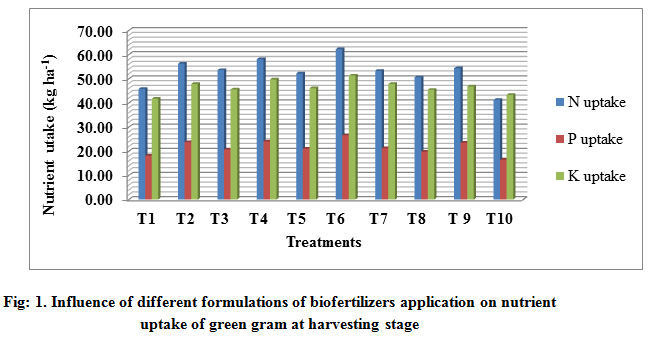 |
Figure 1: Influence of different formulations of biofertilizers application on nutrient uptake of green gram at harvesting stage |
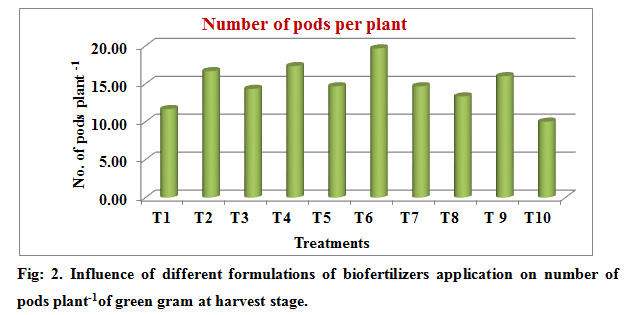 |
Figure 2: Influence of different formulations of biofertilizers application on number of pods plant-1of green gram at harvest stage |
The significantly maximum (Table 2 & Fig:3) number of seeds (13.00) pod-1 was recorded in drip fertigation plot treated with liquid based biofertilizers i.e T6 treatment with combination of 100 % RDF and LBBF drip fertigation. The lowest number of (8.00) seeds pod-1 was noticed in T10 (control).
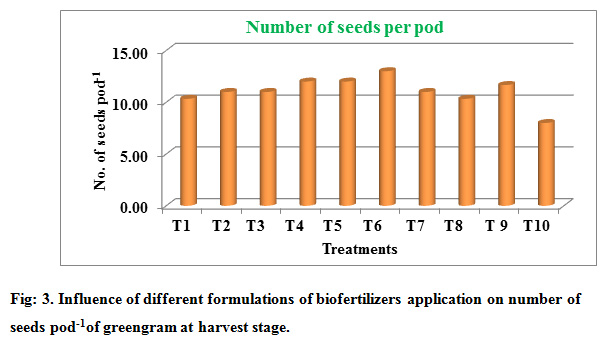 |
Figure 3: Influence of different formulations of biofertilizers application on number of seeds pod-1of greengram at harvest stage |
The significantly (Table 2 & Fig: 4) maximum (38.77 g) test weight of seeds was registered in treatment T6 with combination of 100 % RDF combined with LBBF Drip fertigation. The lowest (22.30 g) test weight was observed in T10 (control). When compared to control in all other treatments test weight of seeds were observed higher.
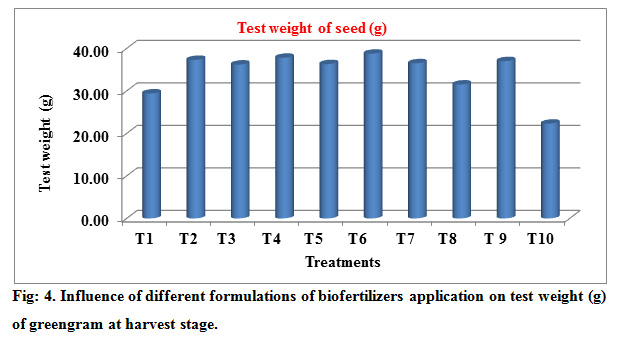 |
Figure 4: Influence of different formulations of biofertilizers application on test weight (g) of greengram at harvest stage |
The seed yield of green gram significantly varied (Table 3 & Fig: 5) due to application of liquid biofertilizers through drip fertigation. It was indicated that the treatment T6 with combination of 100 % RDF along with LBBF drip fertigation recorded significantly higher (1019.50) kg ha-1 seed yield when compared to all the treatments. The lowest seed yield (721.77) kg ha-1 was recorded by treatment T10 (Control). Further, the percent of seed yield increased over T1 (RDF) by T6 was 23.93%.
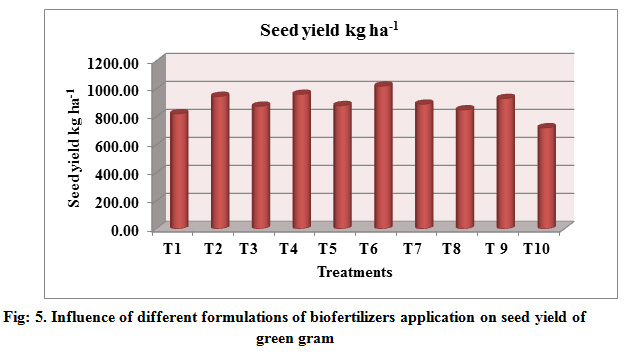 |
Figure 5: Influence of different formulations of biofertilizers application on seed yield of green gram |
Data regarding (Table 3 & Fig: 6) haulm yield of green gram was significantly influenced by drip fertigation with liquid based biofertilizer. Haulm yield is directly related with increase in vegetative growth of the plant. It was observed that the treatment T6 with combined application of 100 % RDF along with LBBF as drip fertigation recorded significantly higher (2543.50) kg ha-1 haulm yield when compared to remaining treatments. Among all the treatments, the lowest (1750.23) kg ha-1 haulm yield was recorded in treatment T10 (Control). Further, it was observed that the percent increased in haulm yield of greengram over T1 (RDF) by T6 was (28.16 %).
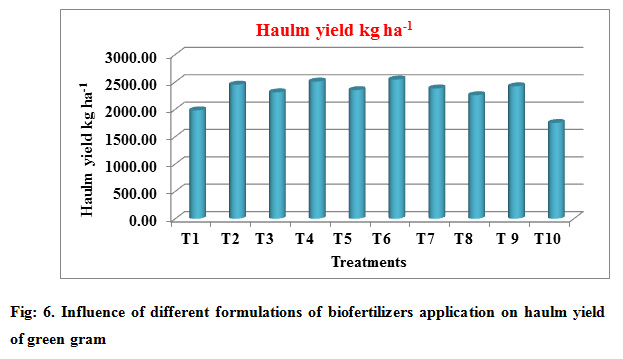 |
Figure 6: Influence of different formulations of biofertilizers application on haulm yield of green gram |
The highest yield and yield attributing characters viz., number of pods plant-1, number of seeds pod-1, test weight (g), Seed yield (kg ha-1) and haulm yield (kg ha-1) was significantly increased due to combined application of liquid biofertilizers and mineral fertilizers with dripfertigation. It might be due to biofertigation can precisely deliver the bio inoculants in the root zone (Gomathy et al., 2008). It is an added advantage whereas microbial inoculants are supplied through biofertigation could be a potential organic input for precision farming, which can be easily delivered through fertigation system for effective colonization of root zone of crop plants. Effective microorganisms were applied in the field along with inorganic materials and it had more water use efficiency and fertilizer use efficiency.
The fertigation with liquid based biofertilizers and 100 % RDF resulted in higher availability of all three major nutrients (N, P and K) in the soil solution, which led to higher uptake and better translocation of assimilates from source to sink, thus in turn increased the yield. Similar linear response was obtained in long duration pigeonpea under drip fertigation by Vimalendren and Latha (2014). Hence, the Precision farming is one among the integrated management approaches of agriculture, which include fertigation and combined practice of organic and inorganic farming to get highest yield and to minimize the cost of farming (Bharathi et al., 2017). Similar results found in (Jeyajothi and Pazhanivelan, 2017) increased drymatter production, nutrient uptake, seed yield per ha-1 and stalk yield per ha-1 obtained from 125 percent RDF through WSF under drip fertigation. Hence, the perusal of the yield and nutrient upatke data showed the favourable effect of drip fertigation on yield of Greengram. The yield per hectare was significantly improved by the application of major nutrients through fertigation and liquid bofertilizers as biofertigation, which boosted the overall vegetative growth and biological efficiency of the plant. The findings of the foregoing experiments have clearly established that fertigation is definitely advantageous over the surface irrigation with basal application of fertilizers.
Table 2: Influence of different formulations of biofertilizers application on yield attributing characters of greengram at harvest stage
| Treatments | No.of pods plant-1 | No. of Seeds
pod-1 |
Test weight of seeds (g) |
| T1 : 100 % RDF | 11.67 | 10.33 | 29.40 |
| T2 : 100 % RDF + CBBF Seed treatment | 16.67 | 11.00 | 37.30 |
| T3 : 100 % RDF + CBBF Soil treatment | 14.33 | 11.00 | 36.20 |
| T4 : 100 % RDF + LBBF Seed treatment | 17.33 | 12.00 | 37.80 |
| T5 : 100 % RDF + LBBF Soil treatment | 14.67 | 12.00 | 36.30 |
| T6 : 100 % RDF + LBBF Drip fertigation | 19.67 | 13.00 | 38.77 |
| T7 : 100 % RDF + LCBF Seed treatment | 14.67 | 11.00 | 36.50 |
| T8 : 100 % RDF + LCBF Soil treatment | 13.33 | 10.33 | 31.50 |
| T9 : 100 % RDF + LCBF Drip fertigation | 16.00 | 11.67 | 37.00 |
| T10 Control : Only biofertilizers | 10.00 | 8.00 | 22.30 |
| SE(m) |
1.12 |
0.67 |
0.87 |
| CD(P=0.05) |
3.37 |
2.02 |
2.61 |
| CV |
13.14 |
10.62 |
4.41 |
Table 3: Influence of different formulations of biofertilizers application on seed yield and haulm yield of green gram
| Treatments | Seed yield
(kg ha-1) |
Per cent
increase over RDF (%) |
Haulm yield
(kg ha-1) |
Per cent
increase over RDF (%) |
| T1 : 100 % RDF | 0821.67 | – | 1980.23 | – |
| T2 : 100 % RDF + CBBF Seed treatment | 0945.70 | 15.09 | 2450.20 | 23.73 |
| T3 : 100 % RDF + CBBF Soil treatment | 0875.50 | 06.55 | 2310.20 | 16.66 |
| T4 : 100 % RDF + LBBF Seed treatment | 0960.77 | 16.83 | 2506.70 | 26.32 |
| T5 : 100 % RDF + LBBF Soil treatment | 0880.23 | 07.08 | 2350.07 | 18.48 |
| T6 : 100 % RDF + LBBF Drip fertigation | 1019.50 | 23.93 | 2543.50 | 28.16 |
| T7 : 100 % RDF + LCBF Seed treatment | 0890.20 | 08.29 | 2380.57 | 20.17 |
| T8 : 100 % RDF + LCBF Soil treatment | 0850.23 | 03.45 | 2256.97 | 13.83 |
| T9 : 100 % RDF + LCBF Drip fertigation | 0930.80 | 13.20 | 2420.23 | 22.00 |
| T10 Control : Only biofertilizers | 0721.77 | – | 1750.23 | – |
| SE(m) |
26.32 |
– |
72.65 |
– |
| CD(P=0.05) |
78.82 |
– |
217.55 |
– |
| CV |
5.12 |
– |
5.48 |
– |
Conclusion
Precision farming is one among the integrated management approaches of agriculture, which include fertigation and combined practice of organic and inorganic farming to get highest yield and to minimize the cost of farming. Fertigation system of precision farming is considered as effective delivery of nutrients exactly at the root zone of crop, which minimize the loss as well as reduce the environmental hazards caused by the chemicals. This technology ensures the fertilizer use effectively to a greater extent. Biofertigation can precisely deliver the bio inoculants in the root zone. It is an added advantage whereas microbial inoculants are supplied through biofertigation as it has more water use efficiency and fertilizer use efficiency, quality etc. Effective microorganisms can also applied in the field along with inorganic materials. The results clearly confirmed that bio fertigation could be an effective system which can increase the ultimate output of yields.
Acknowledgement
Authors acknowledge the help and cooperation of Dr. V. Ramulu, Principal Scientist (Agro), Water Technology Centre, College of Agriculture, PJTSAU, Rajendranagar, Hyderabad, for providing facilities to successfully carry out the research work.
References
Bharathi, J., Balachander, D., Kumar, K., Narayanan, R. 2017. Evaluation of new microbial consortium through biofertigation for precision farming of Bhendi (COBH 1). International Journal of Medical Sciences & Pharmaceutical Research. 1(1): 15 – 24.
Bhavya, K., R. Subhash Reddy, S. Triveni, K. Damodara Chari and Nagaraju, Y. 2017. Study of carrier Biofertilizers from Different Production Centers. J.Curr.Microbiol.App.Sci. 6(6): 1776-178.
Brahmaprakash, G.P and Sahu, P.K. 2012. Biofertilizers for Sustainability. Journal of Indian Institute of Science. 92: 37-62.
Chandra, K., Greep, S., Ravindranath, P and Srivathsa, R.S.H. 2005. Liquid Biofertilizers (Government of India, Ministry of Agriculture, Department of Agriculture and Cooperation, Regional Center for Organic Farming). Regional Director, Regional Center for Organic Farming, Bangalore.
Gomathy, M., Sathya, P.D., Thangaraju, M., Sundaram, S.P and Manicka, S.P. 2008. Impact of biofertigation of Azophosmet on cotton yield under drip irrigation. Research Journal of Agriculture and Biological Sciences. 4(6): 695-699.
Jeyajothi, R. and Pazhanivelan, S. 2017. Dry matter, Nutrient Uptake and Yield of Short Duration Pigeon pea (Cajanus cajan ) Varieties under Drip Fertigation system. Int.J.Curr.Microbiol.App.Sci. 6(11): 3958-3965.
Liu, J., Tian, S., Li, B and Qin, G. 2009. Enhancing viability of two biocontrol yeasts in liquid formulation by applying sugar protectant combined with antioxidant. 54: 817-824.
Palanisami, K.K., Mohan, K. R., Kakumanu and Raman, S. 2012. Spread and economics of micro irrigation in India: Evidence from different states. 258-266.
Rishi, N. 2009. Significant plant virus diseases in India and a glimpse of modern disease management technology. J. Gen. Plant Pathol. 75: 1–18.
Sharma, S. B., Sayyed, R. Z., Trivedi, M. H., and Gobi, T. A. (2013). Phosphate solubilizing microbes: sustainable approach for managing phosphorus deficiency in agricultural soils. Springer Plus.2: 587. doi: 10.1186/2193-1801-2-587.
Singh, N., Singh, H and Nagarajan, P. 2013. Development of SSR markers in mung bean, Vigna radiata (L.) Wilczek using in silico J. crop weed. 9: 69–74.
L and K.R. Latha. 2014. Yield, water use and water use efficiency of pigeonpea [Cajanus cajan (L.) Millsp.] under drip fertigation system. JANS. 6(1): 457-462.
Yuming, B., Xiaomin, Z and Smith, D.L. 2003. Enhanced soybean plant growth resulting from co-inoculation of Bacillus strains with Bradyrhizobium japonicum. Crop Science. 43: 1774-1778.


